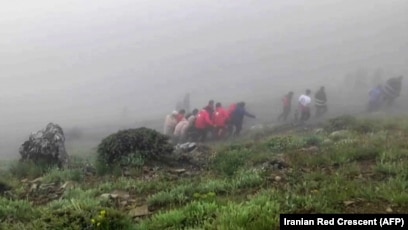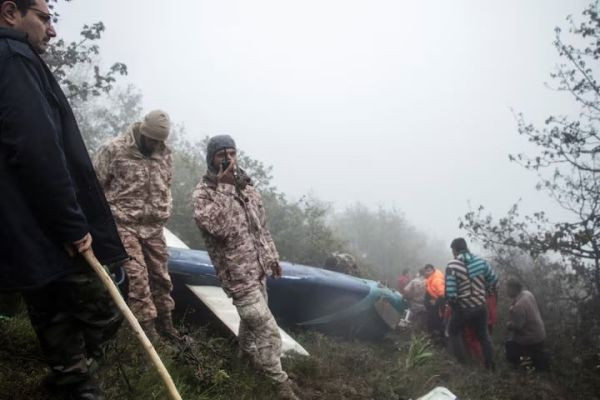The final report on the tragic helicopter crash that claimed the life of Iran’s President and several key government officials has confirmed that bad weather was the primary cause of the accident. The incident, which shocked the nation and sent ripples of grief and uncertainty through the political landscape, occurred during a routine inspection visit to a remote region in the northwest of the country. This conclusive finding, delivered by Iran’s Civil Aviation Organization (CAO), has brought some closure to the investigation but has also raised important questions about safety protocols and decision-making processes in the face of adverse weather conditions.
The Tragic Accident
On a fateful day earlier this year, President Ebrahim Raisi, along with several top officials, boarded a helicopter bound for a remote village in Iran’s West Azerbaijan province. The visit was part of the President’s ongoing efforts to oversee development projects in less accessible areas of the country. However, the mission took a tragic turn when the helicopter encountered severe weather conditions shortly after takeoff. According to the final report, a combination of thick fog, heavy rain, and strong winds created an environment in which the helicopter’s pilots were unable to maintain control of the aircraft.
The helicopter crashed into a mountainous area, killing all on board instantly. The loss of President Raisi, a pivotal figure in Iran’s political landscape, along with other high-ranking officials, plunged the country into mourning. The incident also led to an immediate investigation by the CAO, which has now culminated in the release of this final report.
Findings of the Report
The CAO’s investigation was thorough, involving an extensive review of flight data, communication records, and weather reports from the day of the crash. According to the final report, the primary cause of the crash was indeed the adverse weather conditions that the helicopter encountered shortly after takeoff. The report specifically highlights the role of limited visibility due to dense fog, which made navigation challenging for the pilots. Compounding the issue was the strong turbulence caused by the high winds in the mountainous region, which made it difficult to stabilize the helicopter.
The report also noted that while the helicopter’s crew were experienced and had flown in challenging conditions before, the combination of factors on that day created a situation that was beyond their control. The decision to proceed with the flight despite the deteriorating weather conditions was likely influenced by the pressure to adhere to the President’s schedule, though the report stopped short of assigning blame to any specific individuals.

Reactions to the Report
The confirmation that bad weather was the cause of the crash has elicited mixed reactions in Iran. On one hand, the report has provided a sense of closure by dispelling rumors and speculation about potential sabotage or mechanical failure. However, it has also sparked criticism regarding the decision-making process that led to the flight being undertaken in such perilous conditions.
Many Iranians, particularly those in the political and aviation sectors, have expressed concern over the apparent lack of rigorous safety protocols when it comes to high-profile flights. Critics argue that more stringent procedures should be in place to prevent such tragedies, especially when the nation’s top leadership is involved. There is also a growing call for a reevaluation of how decisions are made in the face of adverse weather conditions, with some suggesting that the pressure to maintain political schedules should never outweigh safety considerations.
The Impact on Iran’s Political Landscape
The loss of President Raisi has had profound implications for Iran’s political landscape. As a leader who was deeply involved in both domestic and international affairs, his death has left a significant void at a critical time. Raisi was known for his conservative policies and his efforts to strengthen Iran’s position on the global stage, particularly in relation to its nuclear program and relations with Western powers.
In the wake of his death, there has been a period of political uncertainty as Iran’s leadership works to navigate the transition to new leadership. The selection of a new President has been a delicate process, with various factions within the government vying for influence. This period of transition has also been marked by public mourning and a sense of national loss, as Raisi was a prominent figure who had garnered both support and criticism during his time in office.
The crash has also sparked a broader conversation about the safety and security of government officials. In response to the report, some lawmakers have called for a comprehensive review of all aviation practices involving government personnel, with the aim of implementing stricter safety measures and ensuring that such a tragedy does not occur again.
Aviation Safety in Iran: A Broader Issue
The helicopter crash has brought renewed attention to the state of aviation safety in Iran, which has faced challenges in recent years due to a combination of factors, including aging aircraft, sanctions that limit access to modern technology, and infrastructure limitations. While the CAO’s report confirms that the crash was caused by weather conditions, it has also highlighted the need for ongoing improvements in the aviation sector.
Iran’s aviation industry has been under significant strain, particularly with the difficulties in procuring new aircraft and parts due to international sanctions. This has forced the country to rely on older fleets, which, while not directly implicated in this particular crash, represent a broader challenge to maintaining safety standards. The government has acknowledged these challenges and has committed to improving aviation infrastructure and safety protocols, though these efforts have been hampered by economic constraints.

In light of the helicopter crash, there is now a renewed urgency to address these issues. Aviation experts and industry professionals have called for greater investment in modernizing Iran’s fleet and improving pilot training, particularly in handling adverse weather conditions. There is also a push for better forecasting and communication systems to ensure that flight crews have the most up-to-date information when making decisions about whether to proceed with a flight.
Moving Forward
The final report on the helicopter crash that killed President Raisi has provided important insights into the factors that led to the tragedy, confirming that bad weather was the primary cause. As Iran comes to terms with the loss of its leader and the other officials who perished in the crash, the nation is also grappling with the lessons to be learned from this incident.
There is a clear need for improved safety protocols, particularly when it comes to flights involving high-profile individuals. The pressure to maintain political schedules must be balanced against the paramount importance of safety, and this will require a cultural shift within both the government and the aviation industry.
Moreover, the tragedy has underscored the broader challenges facing Iran’s aviation sector, particularly in the context of ongoing sanctions and economic difficulties. Addressing these challenges will be critical to ensuring that such a tragedy does not occur again.
As Iran looks to the future, the hope is that the lessons learned from this tragic event will lead to meaningful changes that enhance the safety of all who take to the skies, whether they are government officials or ordinary citizens. The legacy of President Raisi and the others who lost their lives in this crash will hopefully inspire a renewed commitment to aviation safety and the protection of those who serve the nation.



